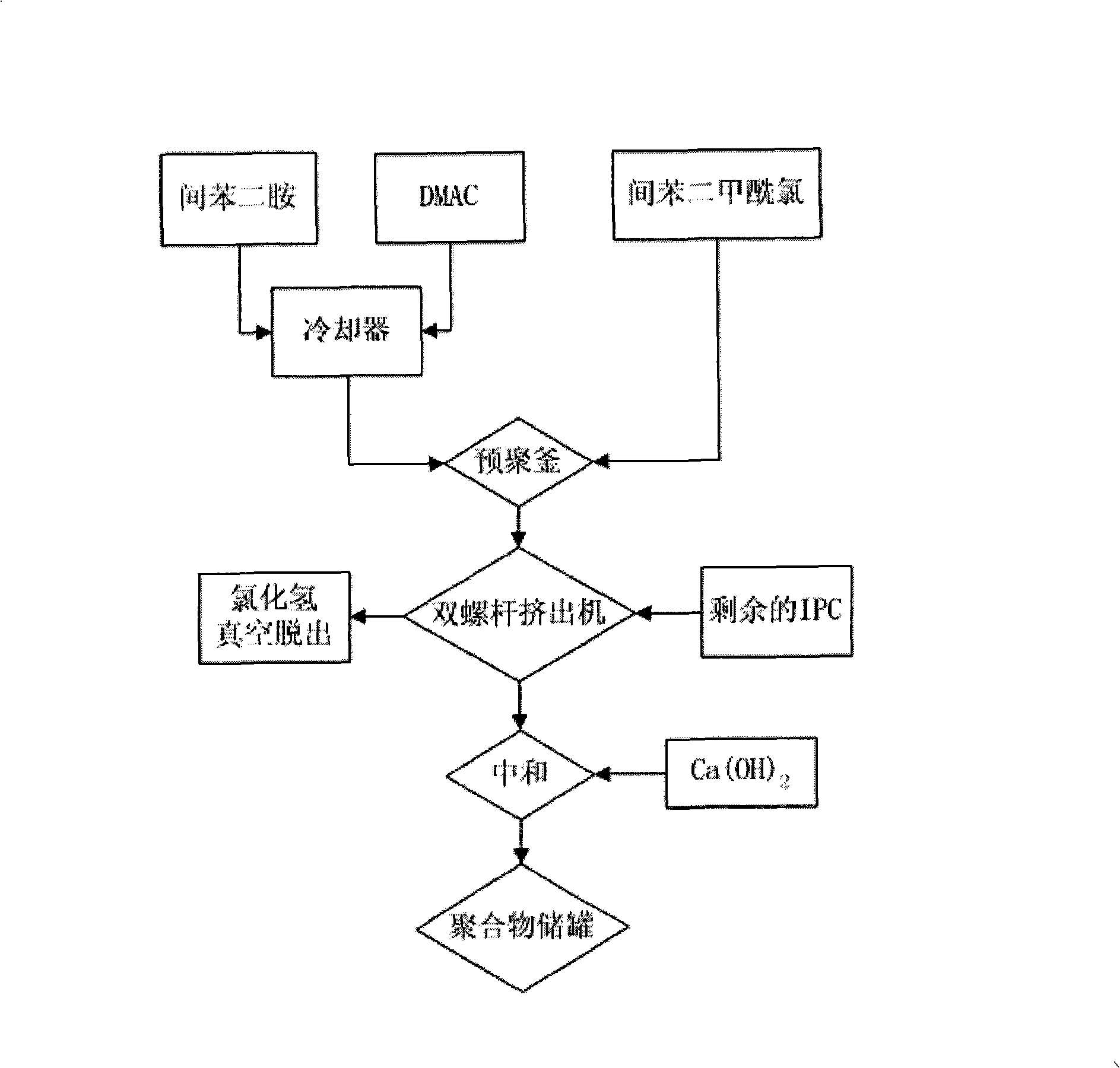Preparation of low salt-containing aramid fiber 1313spinning solution and process for spinning fibre by wet method
A technology of wet spinning and fiber method, which is applied in the preparation of low-salt aramid 1313 spinning solution and its wet spinning fiber field, which can solve the problems of difficult control of equimolar ratio, difficult removal of reaction heat, and molecular weight difference and other problems, to achieve the effect of increasing the molecular weight, reducing the dosage, and reducing the content of hydrogen chloride
- Summary
- Abstract
- Description
- Claims
- Application Information
AI Technical Summary
Problems solved by technology
Method used
Image
Examples
Embodiment 1
[0044] Example 1: Preparation of spinning solution
[0045] Dissolve 1 part of refined MPD in 10.92 parts of freshly distilled dry DMAC, add 1.7 parts of 60°C refined IPC at -10°C for pre-polycondensation to form a prepolymer containing hydrogen chloride, keep the temperature below 0°C After reacting for 20 minutes and the remaining 0.18 parts of molten IPC enter a twin-screw extruder with a diameter of 30 mm, a length-to-diameter ratio of 1:60 and a rotation speed of 200 rpm. Control the temperature of the twin-screw reactor below 50°C, and draw a vacuum through the vent, about 15 minutes to extrude the colorless and transparent polymer, and then proceed to neutralization, Ca(OH) 2 The amount is 0.4 parts. The final result is 16.1% containing polymer, η inh 2.01, relative to polymer CaCl 2 For the spinning solution with a content of 14.8%, the neutralized solution is subjected to pH adjustment, mixing, defoaming, filtering, and entering the next step of spinning.
Embodiment 2
[0046] Example 2: Preparation of spinning solution
[0047]Dissolve 1 part of refined MPD in 10.92 parts of freshly distilled dry DMAC, add 1.6 parts of molten refined IPC to a general reactor with a stirrer at -18°C for pre-condensation to produce hydrogen chloride The prepolymer is kept at a temperature lower than 0°C. After 22 minutes of reaction and the remaining 0.28 parts of molten IPC enters a twin-screw extruder with a diameter of 50mm, a length-to-diameter ratio of 1:50 and a rotation speed of 180rpm. The temperature of the twin-screw reactor is controlled below 55℃, and the vacuum is drawn through the exhaust port, and the colorless and transparent polymer is extruded in about 17 minutes. After the prepolymer containing hydrogen chloride is formed, the neutralization is carried out. Ca(OH ) 2 The amount is 0.25 parts. The final product contains 15.5% polymer, η inh 1.88, relative to polymer CaCl 2 For the spinning solution with a content of 10.1%, the neutralized solutio...
Embodiment 3
[0048] Example 3: Fiber preparation
[0049] The spinning dope prepared in Example 1 of the spinning solution is coagulated through a spinneret with a diameter of 0.07 mm in a coagulation bath at a temperature of 8°C (the coagulation solution contains 15-25% CaCl 2 And 25-40% of the polar amide solvent, namely DMAC or NMP aqueous solution), and stretched 1.8 times in hot water at 78℃. The stretched fiber is immersed in hot water at 98℃ for 6 minutes and then enters It is further stretched 2.1 times in a heat pipe at 286°C, and finally crimped, heat-set, and cut to obtain a finished fiber. The fiber strength is 3.5 cN / dtex and the elongation at break is 33%.
PUM
| Property | Measurement | Unit |
|---|---|---|
| Strength | aaaaa | aaaaa |
| Strength | aaaaa | aaaaa |
Abstract
Description
Claims
Application Information
 Login to View More
Login to View More - R&D
- Intellectual Property
- Life Sciences
- Materials
- Tech Scout
- Unparalleled Data Quality
- Higher Quality Content
- 60% Fewer Hallucinations
Browse by: Latest US Patents, China's latest patents, Technical Efficacy Thesaurus, Application Domain, Technology Topic, Popular Technical Reports.
© 2025 PatSnap. All rights reserved.Legal|Privacy policy|Modern Slavery Act Transparency Statement|Sitemap|About US| Contact US: help@patsnap.com

